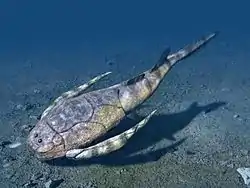Desmatochelys padillai
Desmatochelys padillai is an extinct species of sea turtle described in 2015 and belongs to the family Protostegidae. Estimated to be more than 120 millions years old, it became the oldest known sea turtle, superseding a record earlier held by Santanachelys gaffneyi, which was described in 1998.[1] The fossil, including bones and shells, was discovered from Villa de Leyva in Colombia in 2007.[2] The specimen is larger than an average-sized human, measuring 2 m in length, and exhibits the key features of modern sea turtles.[3] The specific name is given in honour of Carlos Bernardo Padilla, a renowned supporter of the palaeontology of the region.[4]
| Desmatochelys padillai | |
|---|---|
 | |
| Fossil in the Centro de Investigaciones Paleontológicas, Villa de Leyva, Colombia | |
| Scientific classification | |
| Kingdom: | Animalia |
| Phylum: | Chordata |
| Class: | Reptilia |
| Order: | Testudines |
| Suborder: | Cryptodira |
| Family: | †Protostegidae |
| Genus: | †Desmatochelys |
| Species: | †D. padillai |
| Binomial name | |
| †Desmatochelys padillai Cadena and Parham, 2015 | |
Discovery
The fossils of the now known as Desmatochelys padillai were discovered in the 1940s in Colombia. The first systematic study was done by Donald Thomas Jeremy Smith at Kingston Polytechnic, Surrey, England. In a part of his doctoral dissertation in 1989, he suggested the specimen should be classified under the genus Desmatochelys.[5][6] Elizabeth L. Nicholls confirmed this classification in 1992.[7] Due to its incomplete features and lack of information on the geological setting, the species remained undescribed at the museum of University of California, Berkeley. James Parham, who is one of the taxonomic authorities of the species, had seen the original fossils at Berkeley while still a PhD candidate in 1996. He recalled, "If I had known how old the specimens at Berkeley were in 1996, I would have included them in my dissertation, for sure."[8] Better specimens were discovered in 2007 by hobby palaeontologists, Mary Luz Parra and her brothers Juan and Freddy Parra. The specimens were recovered from Villa de Leyva in Colombia. The location is within Paja Formation, which is already dated to belong to Lower Cretaceous, i.e., more than 120 million years old.[9] The fossils were preserved in the collections of the Centro de Investigaciones Paleontológicas in Villa Leyva and the University of California Museum of Paleontology. Formal description was done by Edwin Cadena at the Senckenberg Research Institute, and James Parham at the California State University.[10]
Description
The fossils discovered in 2007 represent an almost complete skeleton. There are four skulls, two are complete and the others are nearly complete. The holotype consists of lower jaw, partial right hyoid, cervical vertebrae (3–8), right and left forelimbs (missing most phalanges), nearly complete carapace, left scapula and coracoid, partial hyoplastron and hypoplastron.[4] The two partial shells are badly preserved but are distinct from those of other marine turtles.[11]
References
- Hirayama, Ren (1998). "Oldest known sea turtle". Nature. 392 (6677): 705–708. doi:10.1038/33669.
- Jandial, Shraddha (8 September 2015). "Oldest fossil sea turtle discovered in Colombia". India Today. Retrieved 18 September 2015.
- "Desmatochelys padillai: Paleontologists Find Oldest Known Species of Sea Turtle". Sci-news.com. 7 September 2015. Retrieved 18 September 2015.
- Cadena, Edwin A.; Parham, James F. (2015). "Oldest known marine turtle? A new protostegid from the Lower Cretaceous of Colombia". PaleoBios. 32 (1): 1–42.
- Smith, Donald T.J. (1989). The cranial morphology of fossil and living sea turtles (Cheloniidae, Dermochelyidae and Desmarochelyidae). England: Kingston Polytechnic. Retrieved 24 September 2015.
- Callaway, Jack M.; Nicholls, Elizabeth L. (1997). Ancient Marine Reptiles. San Diego: Academic Press. p. 246. ISBN 978-0-08-052721-5.
- Nicholls, E.L. (1992). "Note on the occurence [sic] of the marine turtle Desmatochelys (Reptilia: Chelonioidea) from the upper Cretaceous of Vancouver Island". Canadian Journal of Earth Sciences. 29 (2): 377–380. doi:10.1139/e92-033.
- Dodgson, Lindsay (18 September 2015). "World's Oldest Sea Turtle Fossil Discovered". LiveScience. Retrieved 24 September 2015.
- Gaona-Narvaez, T.; Maurrasse, F. J.- M. R.; Etayo-Serna, F. (2013). "Geochemistry, palaeoenvironments and timing of Aptian organic-rich beds of the Paja Formation (Curiti, Eastern Cordillera, Colombia)". Geological Society, London, Special Publications. 382 (1): 31–48. doi:10.1144/SP382.6.
- "Oldest fossil sea turtle discovered: Huge fossilized turtle is at least 120 million years old". ScienceDaily. Retrieved 18 September 2015.
- Virata, John (8 September 2015). "The Oldest Sea Turtle Fossil is 25 Million Years Older Than Previous Fossil". Reptiles. -5 Publishing, LLC. Retrieved 24 September 2015.


.jpg.webp)
